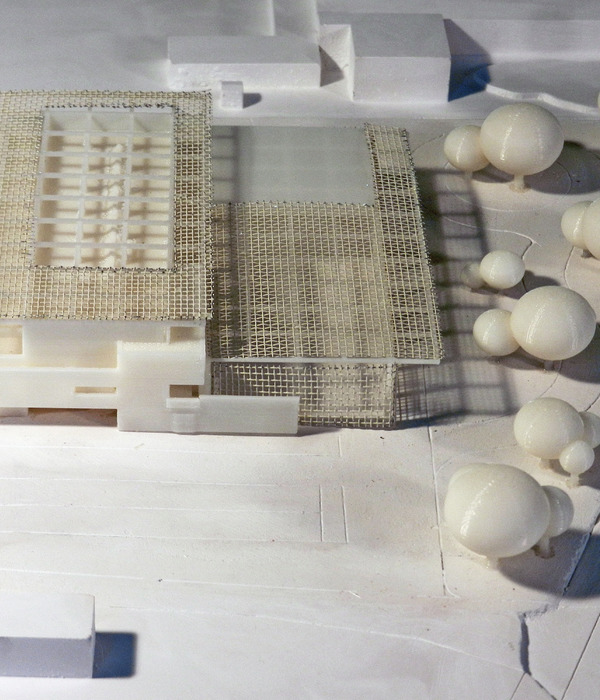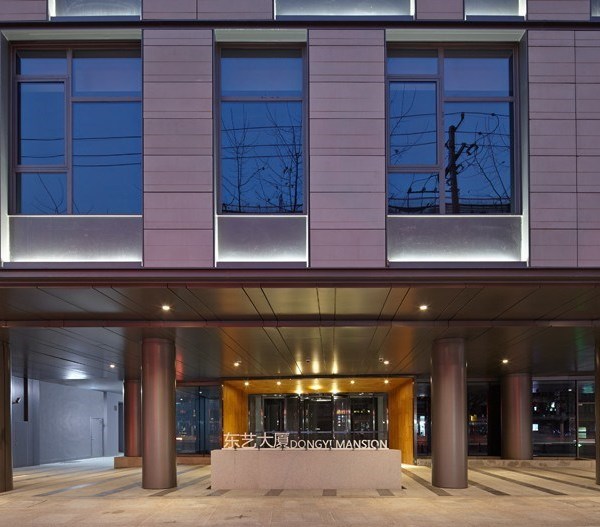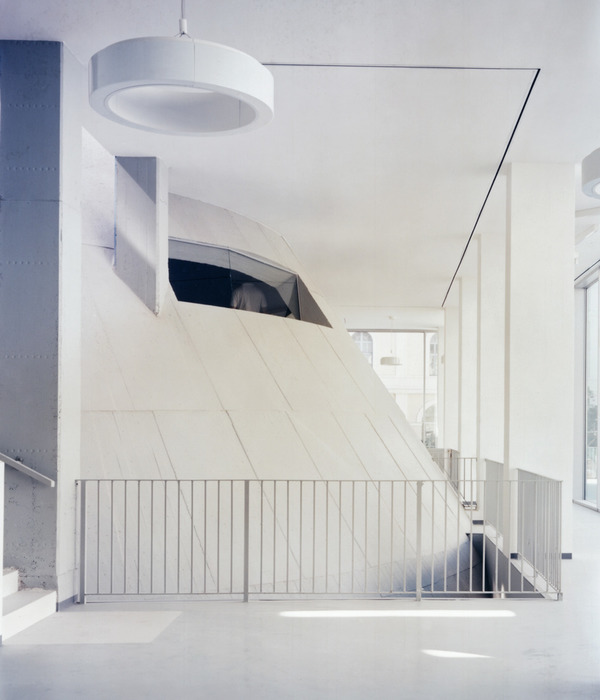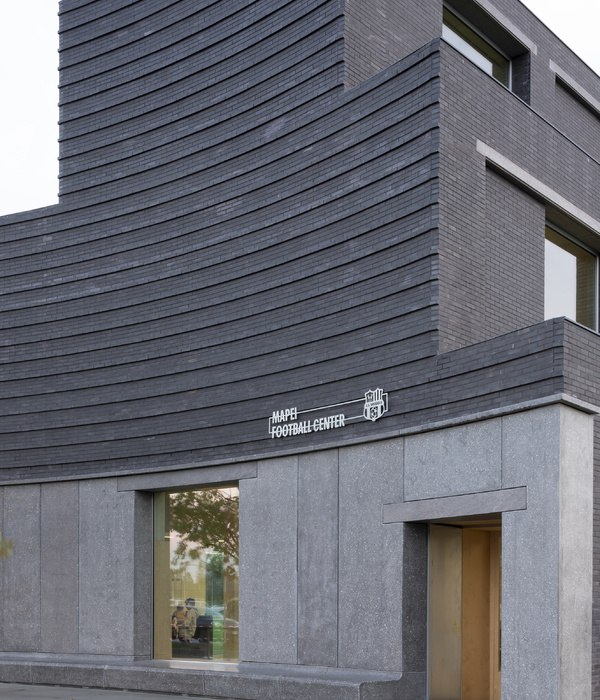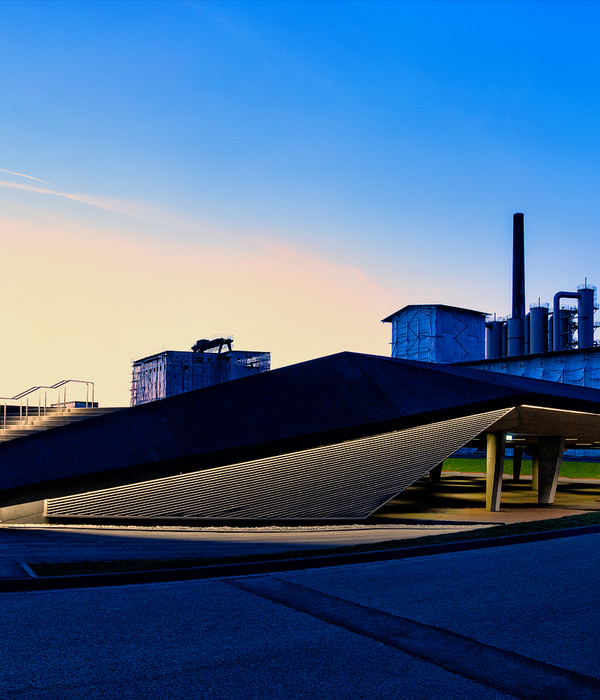国家历史文化名城淮安曾是“漕运之都”。城市格局呈哑铃状,西北的主城和东南的古城以翔宇大道相连。2008 年,政府决定在“哑铃”中部建生态商务新城。同年,“四馆”率先选址于新城翔宇大道东北侧,千年里运河畔,用地面积 5.44ha,总建筑面积 86500㎡。主要功能为规划展示馆、图书馆、文化馆、美术馆及其配套用房。建筑用地为平行翔宇大道的矩形,长 350 米,宽 160 米,分为相对独立的两块:西北的城市博物馆用地和东南的文化三馆用地。规划要求:四个馆统一退后翔宇大道 60 米形成主要展示面。作为体量庞大的首发项目,如何能引领新城风貌、呼应老城文脉、形成地方亲和力?
▼四馆西北鸟瞰,aerial view from northwest ©史巍王棻
Huaian, a historical and cultural city in China, was once the capital of canal transport. The city pattern is dumbbell-shaped. The main city in Northwest and the ancient city in Southeast are connected by Xiangyu Avenue. In 2008, the government decided to build a new eco-business district in the middle of the“ dumbbell”. In the same year, the “Four Pavilions” took the lead in locating on the northeast side of Xiangyu Avenue in the new district, along the millennium Li-canal , with a land area of 5.44ha and a total building area of 86500㎡. The main functions are urban plan exhibition halls, libraries, cultural galleries, art galleries and their supporting rooms. The site is a rectangle parallel to Xiangyu Avenue, 350 meters long and 160 meters wide. It is divided into two relatively independent parts: the northwest Urban Museum land and the southeast Cultural Museum land. The plan calls for a unified retreat of the four pavilions to form a 60-metre display of the main features of Xiangyu Avenue. As the first large sized project there, how can we lead the style and features of the new district, echo the context of the old city and form local affinity?
区位分析图,location analysis
共性与个性的融合:作为多馆合建项目,既要彰显整体的大气简约,又要兼顾个体的多样需求。历史与现代的融合:需契合新城风尚,传承古城文脉,以现代建筑语言呼应传统建筑。实用与象征的融合:兼顾功能与形象,以多元象征手法响应各馆不同功能,增加地方亲和力。建筑与环境的融合:既要卓尔不群形成地标,又要为相邻空白地块留出景观绿脉和视线通廊。
The integration of generality and individuality: As a multi-pavillions joint building, it should not only highlight the overall atmospheric simplicity, but also take into account the diverse needs of individuals.
The integration of history and modernity: it is necessary to conform to the new town fashion, inherit the ancient city context, and echo traditional architecture with modern architectural language.
The integration of practicality and symbolism: giving consideration to functions and images, responding to different functions of libraries by means of multiple symbols, and increasing local affinity.
The integration of architecture and environment: not only to form landmarks, but also to set aside landscape green veins and visual corridors for adjacent blank plots.
▼形态生成示意,design process
虚实相生:各馆的功能对自然采光通风需求有所不同,如门厅、艺术沙龙、创作室、阅览室、音乐厅、展厅等,外立面则以玻璃幕墙、石材百叶、大面积实墙等作为对应,以求虚实相生、合而不同。
To combine real images with virtual ones: The functions of each hall have different requirements for natural lighting and ventilation, such as the foyer, art salon, creative room, reading room, concert hall, exhibition hall, etc. The facade is corresponding to glass curtain wall, stone blinds, large-area solid wall and so on, in order to seek the combination of virtual and reality, and different from each other.
城市博物馆,Urban Plan Museum©马元
▼文化馆,Culture Museum©马元
▼文化馆立面局部,Culture Museum facade©马元
▼文化馆西北立面,northwest facade of the Culture Museum©马元
图书馆外观,library exterior view©马元
图书馆立面如层层书页,the library facade refers to the shape of pages of a book©马元
图书馆立面虚实相生,solid and void of the facade©马元
文脉传承:以大跨、大悬挑、宽窄错缝的干挂蜂窝石材等现代技术,呼应老城历史风貌建筑中的坡顶四合院、挑檐灰空间、清水墙勾缝、檐口椽子收头等。
Context inheritance: With modern technologies such as large span, large cantilever, wide and narrow staggered joints and dry-hanging honeycomb stone, it echoes the quadrangular courtyard on the sloping roof, eaves gray space, hook joints of clear water wall, eaves rafter closure and so on which are existed in the historic buildings of the old city.
图书馆下沉庭院,the sunken courtyard of the library©马元
▼文化馆庭院,Culture Museum courtyard©马元
▼美术馆边庭,ArtMuseumfoyer©马元
图书馆中庭楼梯,stair in the atrium of the library©马元
图书馆中庭,library atrium©马元
地方象征:“四馆”整体造型的灵感源自“漕运之都”淮安最具特点的漕舫,城市博物馆灵感来自厚重的古城楼,音乐厅的造型由 12 片“花瓣”组成,象征淮安市花月季绽放。
Local symbol: Huaian is the capital of canal transport. The inspiration of the overall shape of the “Four Pavilions” comes from Huaian’s Most Characteristic Caofang. The inspiration of the Urban Plan Museum comes from the heavy ancient Gate Tower. The shape of the concert hall is composed of 12 “petals”, which symbolizes the blooming of Huaian’s roses.
▼从里运河看四馆立面,view to the“Four Pavilions”from the canal©马元 ©王棻
▼城市博物馆灵感来自厚重的古城楼,he inspiration of the Urban Plan Museum comes from the heavy ancient Gate Tower©马元
▼音乐厅象征淮安市花月季绽放,the shape of the concert hall symbolizes the blooming of Huaian’s roses©马元
景观渗透:通过压低建筑的中部,将各馆脱开成庭院,辅以各式灰空间,实现室内外交融,并与周边城市开放空间互为渗透,为相邻待开发地块留出景观绿脉和视线通廊。
Landscape infiltration: By lowering the central part of the building, the pavilions are separated into courtyards, supplemented by various grey spaces, to achieve indoor and outdoor integration, and to infiltrate into the open space of the surrounding cities, leaving a landscape green vein and a vision corridor for the adjacent areas to be developed.
场地景观鸟瞰,aerial view to the site©史巍 ©王棻
层层出挑的室外空间:为获得更多的户外景观空间,增加室内外空间渗透,建筑结合外倾墙面,层层叠叠设置了多处阳台、露台、屋顶花园和灰空间,长 80 米的钢筋混凝土结构,悬挑达 12 米。
Cantilever outdoor space: In order to obtain more outdoor landscape space and increase the infiltration of indoor and outdoor space, the building combines with outward inclined wall, layers of balconies, roof gardens and gray space are set up, 80 meters long reinforced concrete structure, cantilever up to 12 meters.
图书馆大露台,terrace of the library©马元
庭院与屋顶花园,courtyard and green roof©史巍 ©王棻
图书馆不同标高的阳台,balconies with different height©马元
有机整合的设备装置:以音乐厅为例,平面接近矩形,高约 10 米,两侧需布置大型暖通设备,于是将平面整合成圆形,并结合设备通风,外墙均布百叶,继而生成了 12 片外倾墙,仿佛绽放的月季花瓣。
Organic integration of equipment and devices: Concert hall for example, the plane is nearly rectangular, about 10 meters high, large-scale heating and ventilation equipment is needed on both sides, so the plane is integrated into a circle, combined with equipment ventilation, part of the outer wall is covered with louvers, and then generated 12 inclined walls, as if blooming rose petals.
音乐厅夜景,Concert Hall night view©马元
干净的第五立面:利用斜屋面高于平屋面的那些部分,巧妙的设计了出屋面的竖井和机房,再通过轻质遮阳构架将出屋面的设备、管线做了遮挡,确保第五立面的美观。
The Fifth Facade: Using those parts of inclined roof higher than flat roof, the roof shaft and machine room are skillfully designed, and then the roof equipment and pipelines are shielded by light shading frame to ensure the beauty of the fifth facade.
▼夕阳下的运河与四馆,the canal and pavilions in the sunset©史巍 ©王棻
宽窄错缝:展厅、音乐厅、书库等外墙以实墙面为主。受楚州周恩来故居外墙清水砖墙宽窄勾缝的启发,石材长 1350 至 1800,以 150/300/600 三种宽度横向干挂,并错缝 1/3。为确保大体量实墙的简洁,尤其是外倾墙面安全性,采用自重轻、块面大的干挂蜂窝石材。
Wide and narrow staggered seams: Exhibition hall, concert hall, library and other external walls are mainly solid walls. Inspired by the wide and narrow joints of the clear-water brick wall of Zhou Enlai’s former residence in Chuzhou, the stone is 1350 to 1800 in length, dry-hanged with 150/300/600 three widths and staggered by one third. In order to ensure the simplicity of large solid walls, especially the safety of extroverted walls, dry-hanging honeycomb stones with light self-weight and large block surface are used.
▼宽窄错缝干挂蜂窝石材,dry-hanged stone facade©马元
石材百叶:阅览室、工作室等采用了“石材百叶”和玻璃幕墙的结合,兼顾了功能、视野、形象和节能。将蜂窝石材板拼接成 300 宽×450 深的通长柱状构件,再按 1050 中心距横向排开,窗洞宽度约 750。
Stone louvers: Reading rooms and studios adopt the combination of “stone louvers” and glass curtain wall, taking into account the functions, vision, image and energy saving. The honeycomb stone slab is spliced into 300 wide *450 deep through-long column members, and then arranged transversely according to 1050 center distance, with the width of the window about 750.
▼“百叶”和玻璃幕墙的结合,the combination of“stone louvers”and glass curtain wall©马元
檐下空间:外挑的“石材百叶”底部垂直收至玻璃幕墙,犹如传统坡顶建筑挑檐底部椽子收头的效果,使得这个现代文化建筑的檐下空间有了些许文脉的传承。
Under the eaves: The bottom of the “stone louver” is vertically closed to the glass curtain wall, just like the effect of the bottom of the eaves of the traditional sloping building, which makes the space under the eaves of this modern cultural building have some inheritance of Context.
的“石材百叶”底部垂直收至玻璃幕墙,the bottom of the“stone louver”is vertically closed to the glass curtain wall©马元
从设计到竣工,十年磨一“舰”,希望“四馆”犹如一艘“文化航母”驶进千家万户的文化生活,引领淮安全新的未来。
From the design to the completion of the project, we hope that the “Four Pavilions” will be like a “cultural carrier” sailing into the cultural life of millions of households and leading a new future of Huaian.
▼首层平面图,ground floor plan
二层平面图,first floor plan
▼四层平面图,third floor plan
▼五层平面图,forth floor plan
▼屋顶平面图,roof plan
▼剖面图,sections
{{item.text_origin}}



